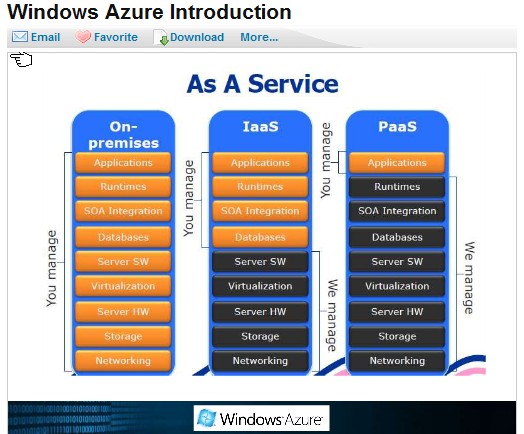The cloud slide Steve Ballmer should have shown

There have been lots of blogs, tweets and news stories covering Microsoft CEO Steve Ballmer's talk at the University of Washington on March 4 about Microsoft's commitment to cloud computing.
I didn't intend to write about Ballmer's hour-plus presentation because there was no news. But the more I thought about his talk, the more I felt it merited comment -- at least in terms of the seeming intent behind his words.
Ballmer highlighted a variety of products -- everything from Windows Phone 7, to Bing Maps, to the Natal gaming controller -- and touted all of these as proof that Microsoft is a leader in cloud computing. Ballmer said 70 percent of Microsoft's workforce is currently engaged in cloud-computing or cloud-related activities and by next year, that percentage would be 90 percent.Based on his presentation, Ballmer seemingly was using the terms "cloud" and "Internet" interchangeably. But to me, the Web is not the same as the cloud. Then again, maybe I'm just splitting hairs...
I understand that there is no single cloud. Is Microsoft Hotmail a cloud app? Sure, it runs in Microsoft's datacenters somewhere. Ditto with Xbox Live, the Danger Sidekick services, Office Web Apps, Windows Live services, Microsoft's hosted Business Productivity Online Services (BPOS), etc. There are lots of Microsoft servers different Web-based apps and services out there, all of which could be called part of "the cloud" even though none of the ones I've mentioned is running on Microsoft's Windows Azure.
Oh yeah. Azure .... When most pundits and industry observers talk about Microsoft and its cloud strategy, they mean Azure. I bet a lot of Microsoft's customers and developers think this way, too. Ballmer made very few references in his UW talk today to Azure -- maybe because on the Azure cloud front, Microsoft is playing catch up (at least timing-wise) to others already out there, including Amazon, Google, Salesforce and more.
Ballmer said Microsoft would support the public cloud, the customer (private) cloud, the partner cloud and the governement cloud. Until today, I felt Microsoft's story about how it would do this was pretty clear and straightforward. It was software+services and/or three-screens-and-a-cloud. According to that "story," Microsoft offers users a wide span of choices: Run your applications on-premises; partially on-premises and partially in the cloud; or completely in the cloud. On the cloud side, these applications can be hosted by Microsoft partners and/or Microsoft.
In other words, like this. (Click on the slide below to enlarge. Note IaaS is Infrastructure as a service and PaaS is platform as a service.):
(from "Introduction to Windows Azure" by Softie Lynn Langit)
So why did Ballmer deviatie from this script now and trying to broaden the definition of Microsoft's cloud? Some Microsoft-employee blog post write-ups, post-Ballmer's presentation, provided a few clues.
The one I found that offered the most coherent and plausible explanation for Ballmer's more amorphous cloud definition came from Microsoft Senior Product Manager Andrew Kisslo on his "Why Microsoft" blog. Microsoft wants folks to understand the company has been doing "cloud computing" before February 1, 2010 (the date that it began charging customers for Windows Azure) and that "experience maters." The Redmondians want users to know Microsoft is fully committed to the cloud, and that it's a "leader" in cloud computing, not a follower.
I realize the slide above was probably a little too geeky and dry for the UW audience. A demo of Bing Maps was surely a lot more fun than a discussion of blobs and Web/Worker roles. But I think Microsoft is taking a dangerous route in trying to over-simplify its cloud strategy in the hope of being perceived as the leader instead of a follower. Not everything should get the "consumerization of IT" treatment....
What do you think? Did Ballmer convince anyone today that Microsoft is the established leader in the cloud? Or did Microsoft's new messaging backfire?
Update: TechCrunch has Ballmer's internal e-mail to the troops. His message to the Microsoft employees is "All of our products make the cloud better, and the cloud makes our products better." And Microsoft plans to launch an ad campaign, most likely to back its new cloud portal, to make sure no one forgets it....
